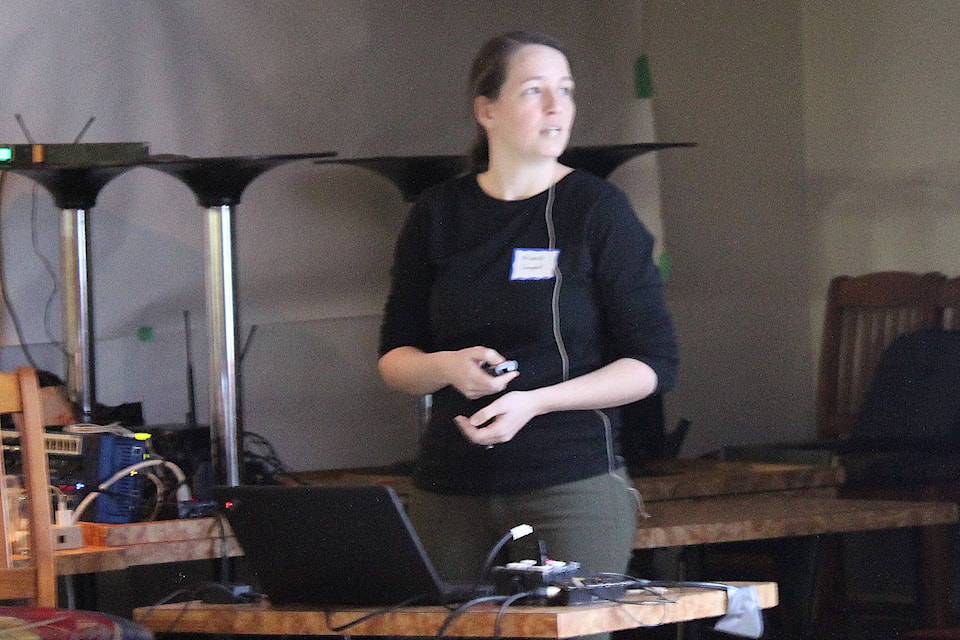The Smithers Exploration Group (SEG) was extremely pleased with its 31st annual Rock Talk held Feb. 19 and 20 at the Smithers Curling Club.
“Rock Talk’s been a real success this year,” said Chris Ogryzlo, SEG president. “We’ve really benefitted by the fact that Northwest B.C. attracts the most exploration dollars of any region in the province and so that means any company who is interested in raising money, is interested in talking about the technology around their project is here, and that’s a real coup for a small town like Smithers.
“I think the other reason this has been so successful this year is we have a new regional geologist in Smithers… A regional geologist leads the way a regional geologist is the person who knows what’s happening in the field, visits all the sites, talks to all the proponents of properties.”
That regional geologist is Sean Tombe. He has been in the position for approximately six months.
“It’s an exciting place to be,” he said. If you’re in B.C., it is the place to be. You’ve got the Golden Triangle and the accessory places around the Golden Triangle. We’ve got a ton of exploration expenditures, you’ve three working mines, so, as I said, it’s the place to be.
Rock Talk is a highly technical forum that attracts exploration and mining companies, prospectors, geologists, engineers and academics.
One speaker who had the curling club buzzing was Duncan McLeish, a Ph.D candidate at McGill University in Montreal who has been studying the deposit at Pretivm’s Brucejack mine. McLeish is looking at how gold is carried in solution in gold vein forming systems.
“This is a new advancement, we’re using a new tool to image at another order of magnification,” he explained. “On a scanning electron microscope you’re looking at a micron scale, now we’re basically down to almost the atomic scale. We’re probably only the second or third people to ever do this on an ore deposit and the first people to certainly do it hear in B.C.”
He said the technique, if it can be industrialized could greatly improve the efficiency of finding economic deposits.
“We’re trying to understand how all these different nanoparticles, what causes them to come together to form nuggets in gold veins” he said. “If you can understand that then you can inform the model that they’re using to target exploration.”
Tombe said it is really valuable to have cutting edge academics in the mix.
“Brucejack and Duncan McLeish are a good example,” he said “From 2017 until now they’ve had a really good academic presence looking towards more exploration using academics and hopefully some successes in the future with that. Those are explorations you can use towards not just at Brucejack, but other places too.”
McLeish said he was glad he was able to come and get up to date on the latest research. He was particularly interested in research by Oregon State University Ph.D student Michelle Campbell who is doing geochemistry and dating on Seabridge Gold’s KSM deposit, which is very nearby Brucejack.
“People have long speculated if Brucejack is the epithermal expression of the KSM system, but now with Campbell’s latest dating, it looks like that deposit is about 10 million years older than Bruce so they look like they’re different systems and that means there’s more potential to find the source at Brucejack.”
SEG was also excited about attracting Newcrest Mining to the Rock Talk. Newcrest acquired the Red Chris mine in August 2019 and is a leading expert in a relatively new technique of underground mining called block caving that they plan to use to extend Red Chris mine’s lifespan to a multi-generational operation.
“It’s exciting because Newcrest is a major player. In the minerals industry, one of the major companies,” Ogryzlo said. “They come out of Australia, they’re very experienced in technology that will move the Red Chris mine forward.
“The other thing with Newcrest is they have said that they’re here in B.C. because they see B.C. as an important place to be worldwide and that’s the kind of affirmation that we need, international players who can pick up properties and work anywhere in the world [and] choose to work in northern British Columbia.”
